CHCDIV001: Report on Fostering Workplace Diversity and Respect
VerifiedAdded on 2023/01/20
|9
|2199
|48
Report
AI Summary
This report, prepared for Distinction Hotel, addresses the critical topic of workplace diversity. It begins by defining diversity and exploring various types, including sexual orientation, racial, and religious diversity. The report then outlines strategies for demonstrating respect for differences within a team, such as discouraging stereotypes, establishing mentoring opportunities, focusing on strengths, implementing inclusive policies, and ensuring minority representation in leadership. It further examines different approaches to managing diversity, including soft and hard style strategies, and the use of diversity training. The report highlights the advantages of a diverse workforce, such as increased creativity, improved customer experience, and enhanced revenue. Finally, the report provides specific recommendations for Distinction Hotel, including fostering an inclusive culture from the top, creating a safe environment for all employees, connecting with employees on a personal level, and implementing systematic diversity training. The report emphasizes the importance of a diverse and inclusive workplace for organizational success.
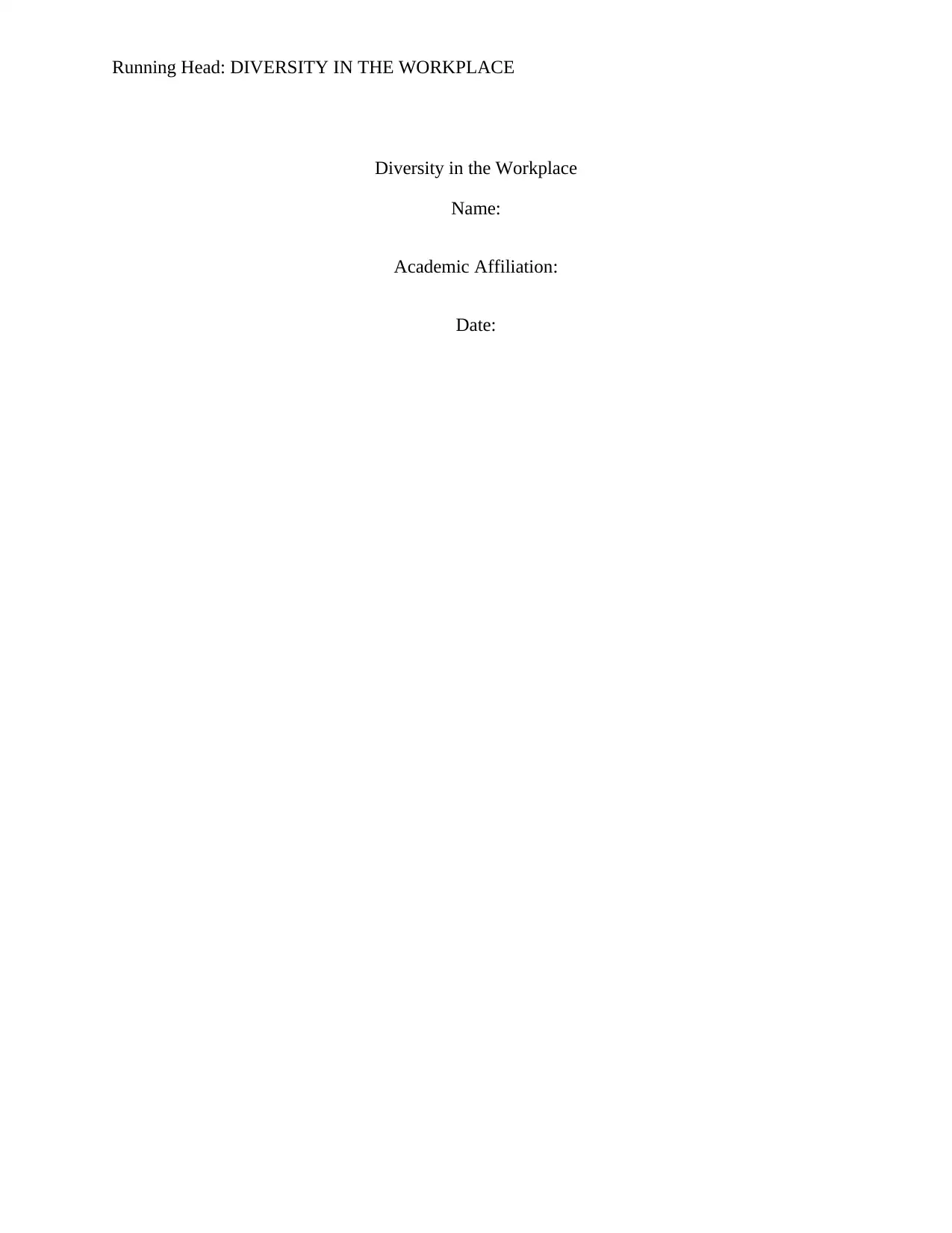
Running Head: DIVERSITY IN THE WORKPLACE
Diversity in the Workplace
Name:
Academic Affiliation:
Date:
Diversity in the Workplace
Name:
Academic Affiliation:
Date:
Paraphrase This Document
Need a fresh take? Get an instant paraphrase of this document with our AI Paraphraser
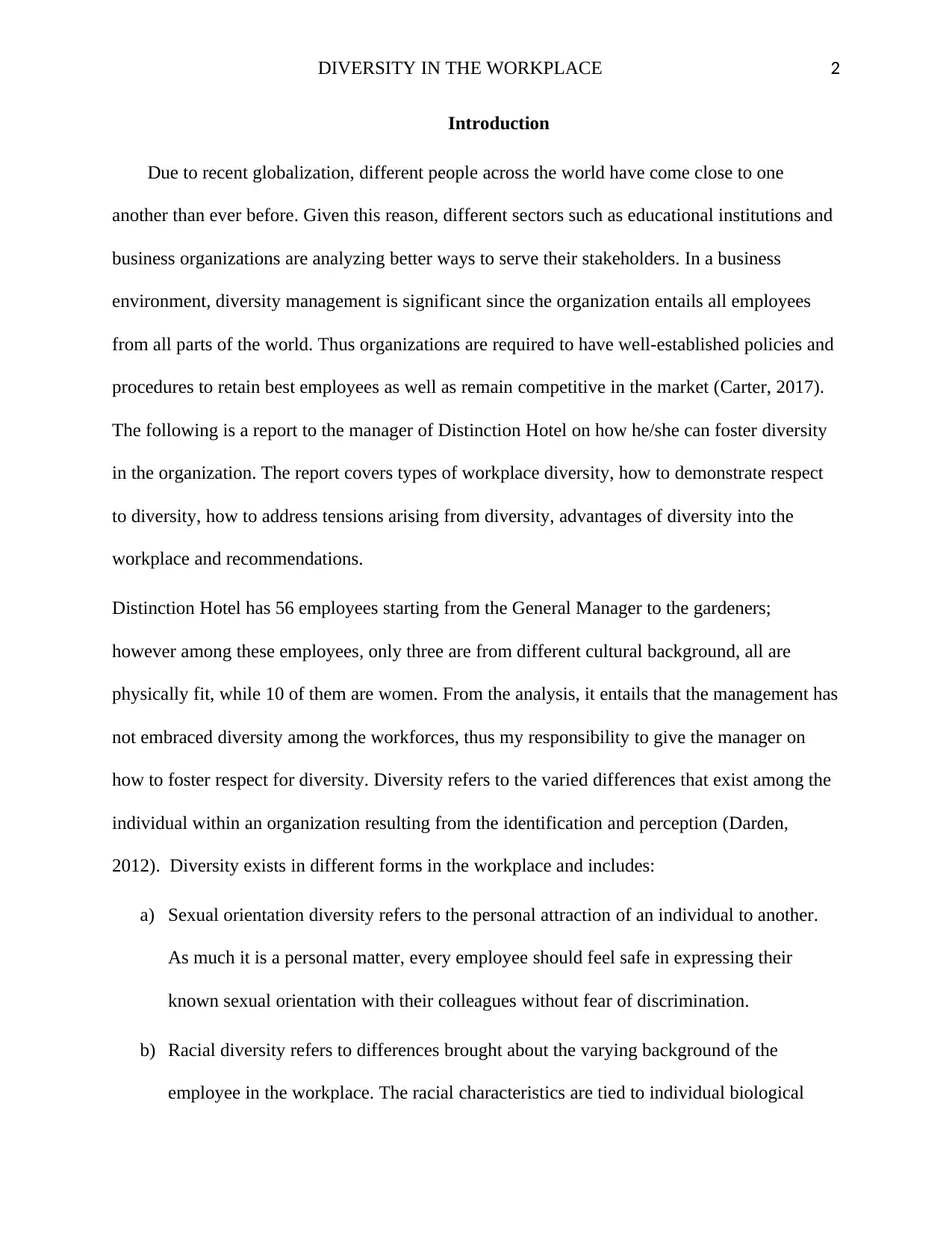
DIVERSITY IN THE WORKPLACE 2
Introduction
Due to recent globalization, different people across the world have come close to one
another than ever before. Given this reason, different sectors such as educational institutions and
business organizations are analyzing better ways to serve their stakeholders. In a business
environment, diversity management is significant since the organization entails all employees
from all parts of the world. Thus organizations are required to have well-established policies and
procedures to retain best employees as well as remain competitive in the market (Carter, 2017).
The following is a report to the manager of Distinction Hotel on how he/she can foster diversity
in the organization. The report covers types of workplace diversity, how to demonstrate respect
to diversity, how to address tensions arising from diversity, advantages of diversity into the
workplace and recommendations.
Distinction Hotel has 56 employees starting from the General Manager to the gardeners;
however among these employees, only three are from different cultural background, all are
physically fit, while 10 of them are women. From the analysis, it entails that the management has
not embraced diversity among the workforces, thus my responsibility to give the manager on
how to foster respect for diversity. Diversity refers to the varied differences that exist among the
individual within an organization resulting from the identification and perception (Darden,
2012). Diversity exists in different forms in the workplace and includes:
a) Sexual orientation diversity refers to the personal attraction of an individual to another.
As much it is a personal matter, every employee should feel safe in expressing their
known sexual orientation with their colleagues without fear of discrimination.
b) Racial diversity refers to differences brought about the varying background of the
employee in the workplace. The racial characteristics are tied to individual biological
Introduction
Due to recent globalization, different people across the world have come close to one
another than ever before. Given this reason, different sectors such as educational institutions and
business organizations are analyzing better ways to serve their stakeholders. In a business
environment, diversity management is significant since the organization entails all employees
from all parts of the world. Thus organizations are required to have well-established policies and
procedures to retain best employees as well as remain competitive in the market (Carter, 2017).
The following is a report to the manager of Distinction Hotel on how he/she can foster diversity
in the organization. The report covers types of workplace diversity, how to demonstrate respect
to diversity, how to address tensions arising from diversity, advantages of diversity into the
workplace and recommendations.
Distinction Hotel has 56 employees starting from the General Manager to the gardeners;
however among these employees, only three are from different cultural background, all are
physically fit, while 10 of them are women. From the analysis, it entails that the management has
not embraced diversity among the workforces, thus my responsibility to give the manager on
how to foster respect for diversity. Diversity refers to the varied differences that exist among the
individual within an organization resulting from the identification and perception (Darden,
2012). Diversity exists in different forms in the workplace and includes:
a) Sexual orientation diversity refers to the personal attraction of an individual to another.
As much it is a personal matter, every employee should feel safe in expressing their
known sexual orientation with their colleagues without fear of discrimination.
b) Racial diversity refers to differences brought about the varying background of the
employee in the workplace. The racial characteristics are tied to individual biological
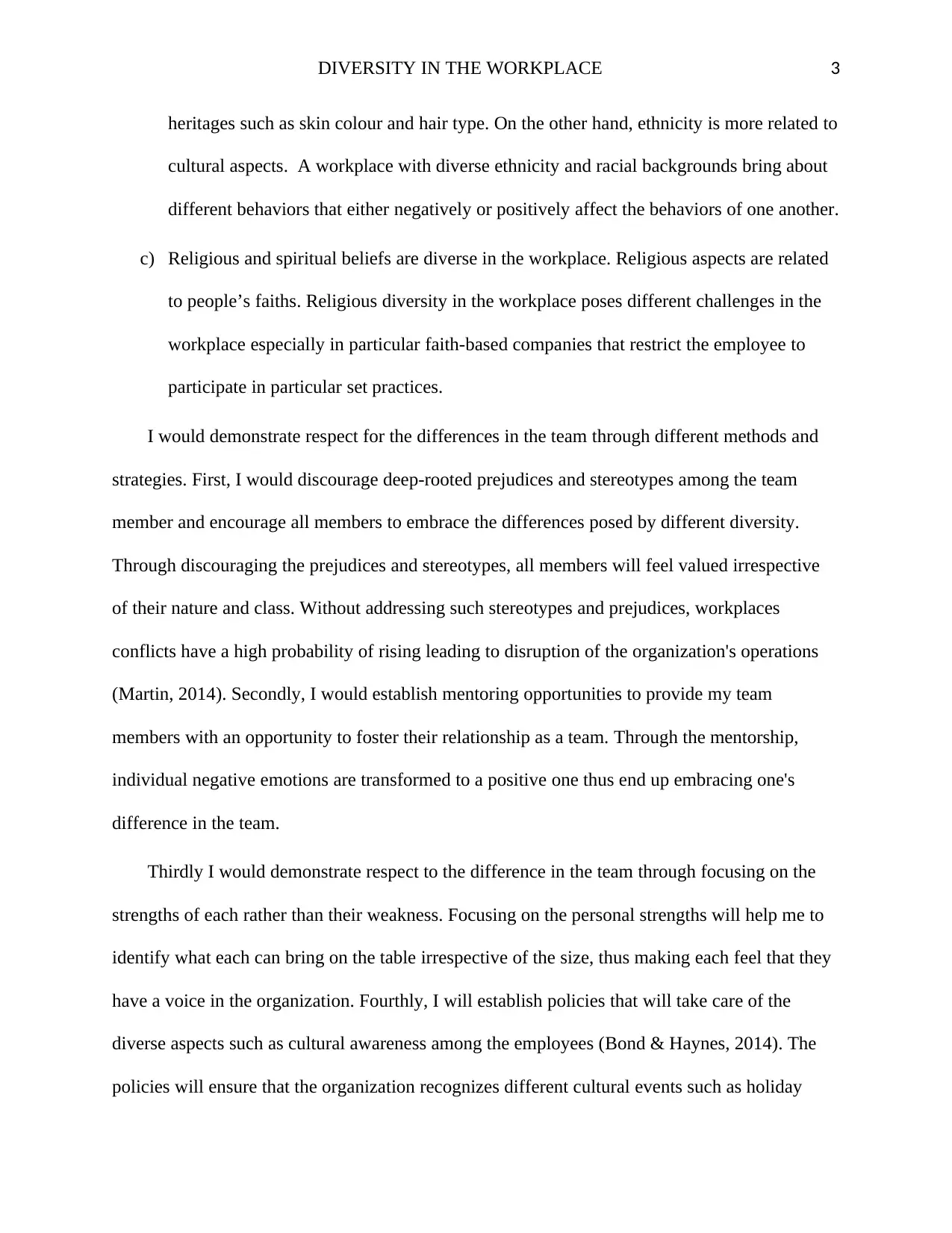
DIVERSITY IN THE WORKPLACE 3
heritages such as skin colour and hair type. On the other hand, ethnicity is more related to
cultural aspects. A workplace with diverse ethnicity and racial backgrounds bring about
different behaviors that either negatively or positively affect the behaviors of one another.
c) Religious and spiritual beliefs are diverse in the workplace. Religious aspects are related
to people’s faiths. Religious diversity in the workplace poses different challenges in the
workplace especially in particular faith-based companies that restrict the employee to
participate in particular set practices.
I would demonstrate respect for the differences in the team through different methods and
strategies. First, I would discourage deep-rooted prejudices and stereotypes among the team
member and encourage all members to embrace the differences posed by different diversity.
Through discouraging the prejudices and stereotypes, all members will feel valued irrespective
of their nature and class. Without addressing such stereotypes and prejudices, workplaces
conflicts have a high probability of rising leading to disruption of the organization's operations
(Martin, 2014). Secondly, I would establish mentoring opportunities to provide my team
members with an opportunity to foster their relationship as a team. Through the mentorship,
individual negative emotions are transformed to a positive one thus end up embracing one's
difference in the team.
Thirdly I would demonstrate respect to the difference in the team through focusing on the
strengths of each rather than their weakness. Focusing on the personal strengths will help me to
identify what each can bring on the table irrespective of the size, thus making each feel that they
have a voice in the organization. Fourthly, I will establish policies that will take care of the
diverse aspects such as cultural awareness among the employees (Bond & Haynes, 2014). The
policies will ensure that the organization recognizes different cultural events such as holiday
heritages such as skin colour and hair type. On the other hand, ethnicity is more related to
cultural aspects. A workplace with diverse ethnicity and racial backgrounds bring about
different behaviors that either negatively or positively affect the behaviors of one another.
c) Religious and spiritual beliefs are diverse in the workplace. Religious aspects are related
to people’s faiths. Religious diversity in the workplace poses different challenges in the
workplace especially in particular faith-based companies that restrict the employee to
participate in particular set practices.
I would demonstrate respect for the differences in the team through different methods and
strategies. First, I would discourage deep-rooted prejudices and stereotypes among the team
member and encourage all members to embrace the differences posed by different diversity.
Through discouraging the prejudices and stereotypes, all members will feel valued irrespective
of their nature and class. Without addressing such stereotypes and prejudices, workplaces
conflicts have a high probability of rising leading to disruption of the organization's operations
(Martin, 2014). Secondly, I would establish mentoring opportunities to provide my team
members with an opportunity to foster their relationship as a team. Through the mentorship,
individual negative emotions are transformed to a positive one thus end up embracing one's
difference in the team.
Thirdly I would demonstrate respect to the difference in the team through focusing on the
strengths of each rather than their weakness. Focusing on the personal strengths will help me to
identify what each can bring on the table irrespective of the size, thus making each feel that they
have a voice in the organization. Fourthly, I will establish policies that will take care of the
diverse aspects such as cultural awareness among the employees (Bond & Haynes, 2014). The
policies will ensure that the organization recognizes different cultural events such as holiday
⊘ This is a preview!⊘
Do you want full access?
Subscribe today to unlock all pages.

Trusted by 1+ million students worldwide
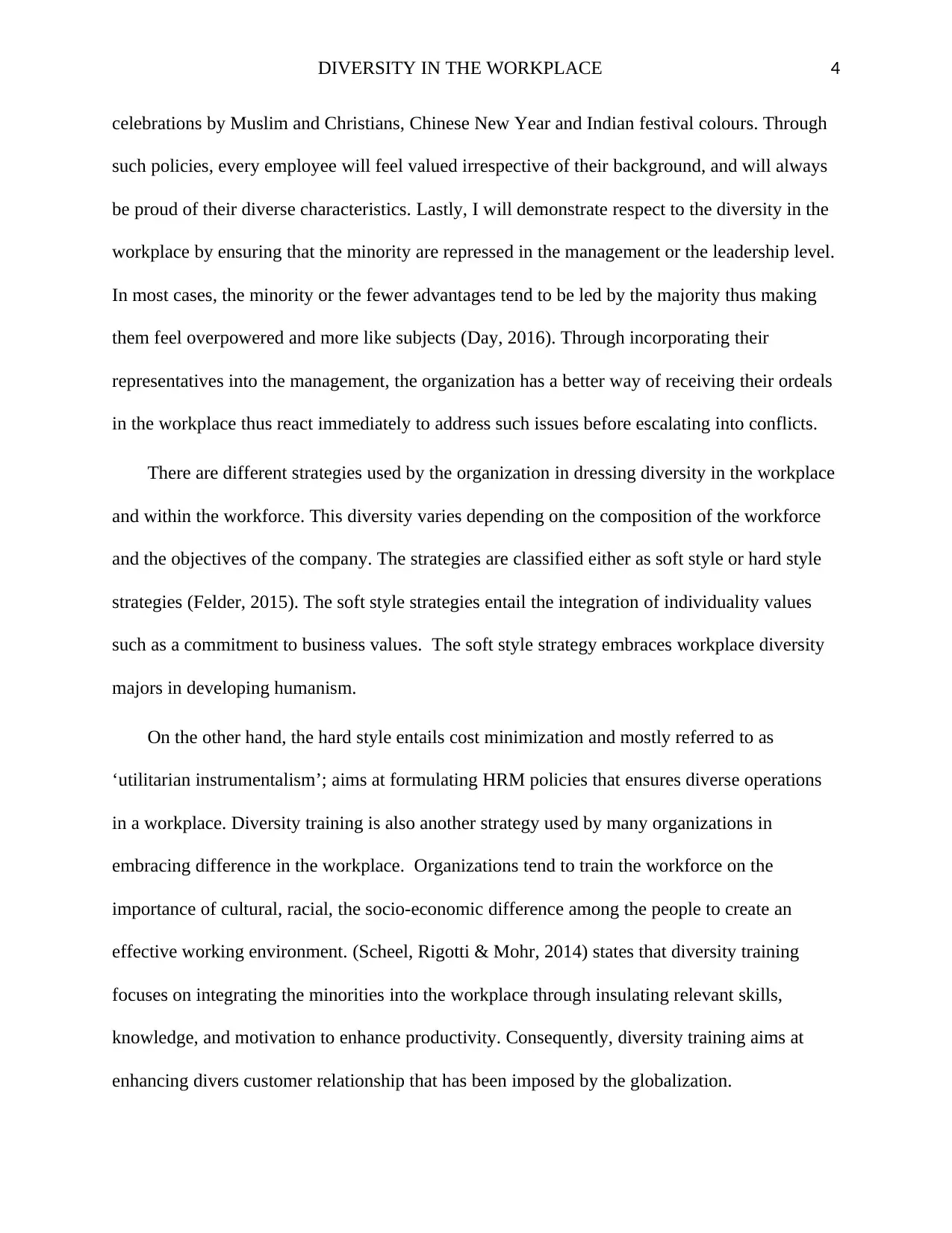
DIVERSITY IN THE WORKPLACE 4
celebrations by Muslim and Christians, Chinese New Year and Indian festival colours. Through
such policies, every employee will feel valued irrespective of their background, and will always
be proud of their diverse characteristics. Lastly, I will demonstrate respect to the diversity in the
workplace by ensuring that the minority are repressed in the management or the leadership level.
In most cases, the minority or the fewer advantages tend to be led by the majority thus making
them feel overpowered and more like subjects (Day, 2016). Through incorporating their
representatives into the management, the organization has a better way of receiving their ordeals
in the workplace thus react immediately to address such issues before escalating into conflicts.
There are different strategies used by the organization in dressing diversity in the workplace
and within the workforce. This diversity varies depending on the composition of the workforce
and the objectives of the company. The strategies are classified either as soft style or hard style
strategies (Felder, 2015). The soft style strategies entail the integration of individuality values
such as a commitment to business values. The soft style strategy embraces workplace diversity
majors in developing humanism.
On the other hand, the hard style entails cost minimization and mostly referred to as
‘utilitarian instrumentalism’; aims at formulating HRM policies that ensures diverse operations
in a workplace. Diversity training is also another strategy used by many organizations in
embracing difference in the workplace. Organizations tend to train the workforce on the
importance of cultural, racial, the socio-economic difference among the people to create an
effective working environment. (Scheel, Rigotti & Mohr, 2014) states that diversity training
focuses on integrating the minorities into the workplace through insulating relevant skills,
knowledge, and motivation to enhance productivity. Consequently, diversity training aims at
enhancing divers customer relationship that has been imposed by the globalization.
celebrations by Muslim and Christians, Chinese New Year and Indian festival colours. Through
such policies, every employee will feel valued irrespective of their background, and will always
be proud of their diverse characteristics. Lastly, I will demonstrate respect to the diversity in the
workplace by ensuring that the minority are repressed in the management or the leadership level.
In most cases, the minority or the fewer advantages tend to be led by the majority thus making
them feel overpowered and more like subjects (Day, 2016). Through incorporating their
representatives into the management, the organization has a better way of receiving their ordeals
in the workplace thus react immediately to address such issues before escalating into conflicts.
There are different strategies used by the organization in dressing diversity in the workplace
and within the workforce. This diversity varies depending on the composition of the workforce
and the objectives of the company. The strategies are classified either as soft style or hard style
strategies (Felder, 2015). The soft style strategies entail the integration of individuality values
such as a commitment to business values. The soft style strategy embraces workplace diversity
majors in developing humanism.
On the other hand, the hard style entails cost minimization and mostly referred to as
‘utilitarian instrumentalism’; aims at formulating HRM policies that ensures diverse operations
in a workplace. Diversity training is also another strategy used by many organizations in
embracing difference in the workplace. Organizations tend to train the workforce on the
importance of cultural, racial, the socio-economic difference among the people to create an
effective working environment. (Scheel, Rigotti & Mohr, 2014) states that diversity training
focuses on integrating the minorities into the workplace through insulating relevant skills,
knowledge, and motivation to enhance productivity. Consequently, diversity training aims at
enhancing divers customer relationship that has been imposed by the globalization.
Paraphrase This Document
Need a fresh take? Get an instant paraphrase of this document with our AI Paraphraser
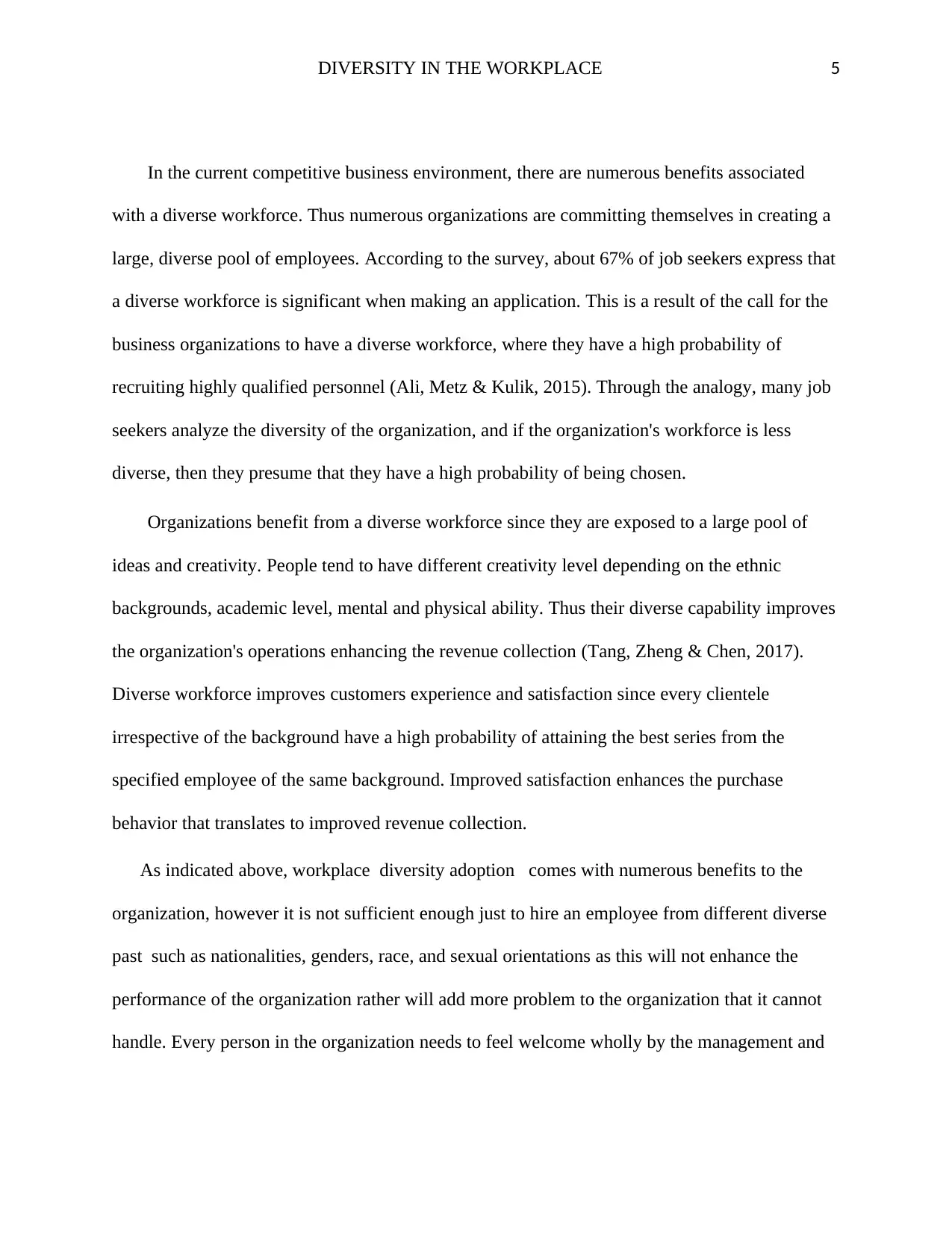
DIVERSITY IN THE WORKPLACE 5
In the current competitive business environment, there are numerous benefits associated
with a diverse workforce. Thus numerous organizations are committing themselves in creating a
large, diverse pool of employees. According to the survey, about 67% of job seekers express that
a diverse workforce is significant when making an application. This is a result of the call for the
business organizations to have a diverse workforce, where they have a high probability of
recruiting highly qualified personnel (Ali, Metz & Kulik, 2015). Through the analogy, many job
seekers analyze the diversity of the organization, and if the organization's workforce is less
diverse, then they presume that they have a high probability of being chosen.
Organizations benefit from a diverse workforce since they are exposed to a large pool of
ideas and creativity. People tend to have different creativity level depending on the ethnic
backgrounds, academic level, mental and physical ability. Thus their diverse capability improves
the organization's operations enhancing the revenue collection (Tang, Zheng & Chen, 2017).
Diverse workforce improves customers experience and satisfaction since every clientele
irrespective of the background have a high probability of attaining the best series from the
specified employee of the same background. Improved satisfaction enhances the purchase
behavior that translates to improved revenue collection.
As indicated above, workplace diversity adoption comes with numerous benefits to the
organization, however it is not sufficient enough just to hire an employee from different diverse
past such as nationalities, genders, race, and sexual orientations as this will not enhance the
performance of the organization rather will add more problem to the organization that it cannot
handle. Every person in the organization needs to feel welcome wholly by the management and
In the current competitive business environment, there are numerous benefits associated
with a diverse workforce. Thus numerous organizations are committing themselves in creating a
large, diverse pool of employees. According to the survey, about 67% of job seekers express that
a diverse workforce is significant when making an application. This is a result of the call for the
business organizations to have a diverse workforce, where they have a high probability of
recruiting highly qualified personnel (Ali, Metz & Kulik, 2015). Through the analogy, many job
seekers analyze the diversity of the organization, and if the organization's workforce is less
diverse, then they presume that they have a high probability of being chosen.
Organizations benefit from a diverse workforce since they are exposed to a large pool of
ideas and creativity. People tend to have different creativity level depending on the ethnic
backgrounds, academic level, mental and physical ability. Thus their diverse capability improves
the organization's operations enhancing the revenue collection (Tang, Zheng & Chen, 2017).
Diverse workforce improves customers experience and satisfaction since every clientele
irrespective of the background have a high probability of attaining the best series from the
specified employee of the same background. Improved satisfaction enhances the purchase
behavior that translates to improved revenue collection.
As indicated above, workplace diversity adoption comes with numerous benefits to the
organization, however it is not sufficient enough just to hire an employee from different diverse
past such as nationalities, genders, race, and sexual orientations as this will not enhance the
performance of the organization rather will add more problem to the organization that it cannot
handle. Every person in the organization needs to feel welcome wholly by the management and
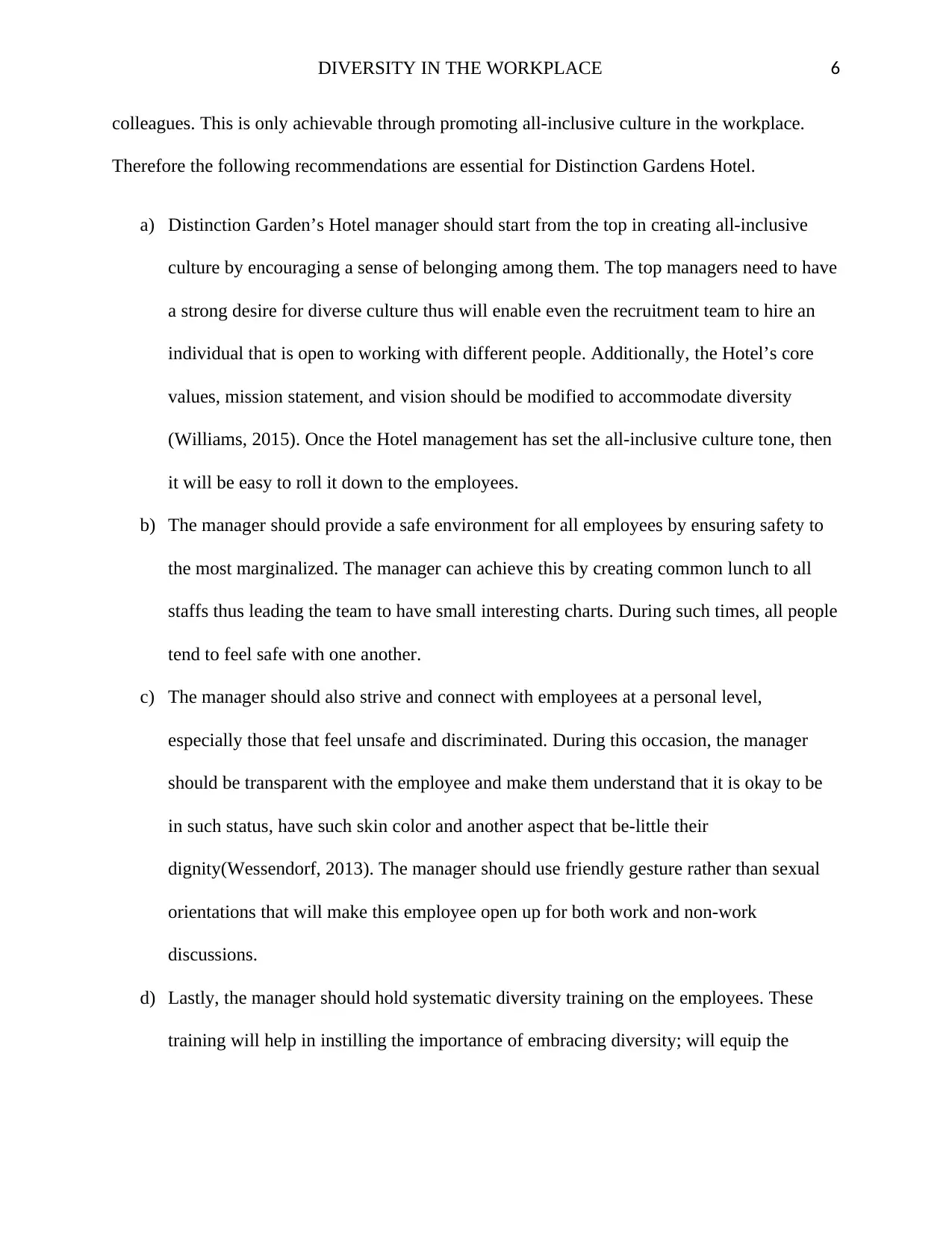
DIVERSITY IN THE WORKPLACE 6
colleagues. This is only achievable through promoting all-inclusive culture in the workplace.
Therefore the following recommendations are essential for Distinction Gardens Hotel.
a) Distinction Garden’s Hotel manager should start from the top in creating all-inclusive
culture by encouraging a sense of belonging among them. The top managers need to have
a strong desire for diverse culture thus will enable even the recruitment team to hire an
individual that is open to working with different people. Additionally, the Hotel’s core
values, mission statement, and vision should be modified to accommodate diversity
(Williams, 2015). Once the Hotel management has set the all-inclusive culture tone, then
it will be easy to roll it down to the employees.
b) The manager should provide a safe environment for all employees by ensuring safety to
the most marginalized. The manager can achieve this by creating common lunch to all
staffs thus leading the team to have small interesting charts. During such times, all people
tend to feel safe with one another.
c) The manager should also strive and connect with employees at a personal level,
especially those that feel unsafe and discriminated. During this occasion, the manager
should be transparent with the employee and make them understand that it is okay to be
in such status, have such skin color and another aspect that be-little their
dignity(Wessendorf, 2013). The manager should use friendly gesture rather than sexual
orientations that will make this employee open up for both work and non-work
discussions.
d) Lastly, the manager should hold systematic diversity training on the employees. These
training will help in instilling the importance of embracing diversity; will equip the
colleagues. This is only achievable through promoting all-inclusive culture in the workplace.
Therefore the following recommendations are essential for Distinction Gardens Hotel.
a) Distinction Garden’s Hotel manager should start from the top in creating all-inclusive
culture by encouraging a sense of belonging among them. The top managers need to have
a strong desire for diverse culture thus will enable even the recruitment team to hire an
individual that is open to working with different people. Additionally, the Hotel’s core
values, mission statement, and vision should be modified to accommodate diversity
(Williams, 2015). Once the Hotel management has set the all-inclusive culture tone, then
it will be easy to roll it down to the employees.
b) The manager should provide a safe environment for all employees by ensuring safety to
the most marginalized. The manager can achieve this by creating common lunch to all
staffs thus leading the team to have small interesting charts. During such times, all people
tend to feel safe with one another.
c) The manager should also strive and connect with employees at a personal level,
especially those that feel unsafe and discriminated. During this occasion, the manager
should be transparent with the employee and make them understand that it is okay to be
in such status, have such skin color and another aspect that be-little their
dignity(Wessendorf, 2013). The manager should use friendly gesture rather than sexual
orientations that will make this employee open up for both work and non-work
discussions.
d) Lastly, the manager should hold systematic diversity training on the employees. These
training will help in instilling the importance of embracing diversity; will equip the
⊘ This is a preview!⊘
Do you want full access?
Subscribe today to unlock all pages.

Trusted by 1+ million students worldwide
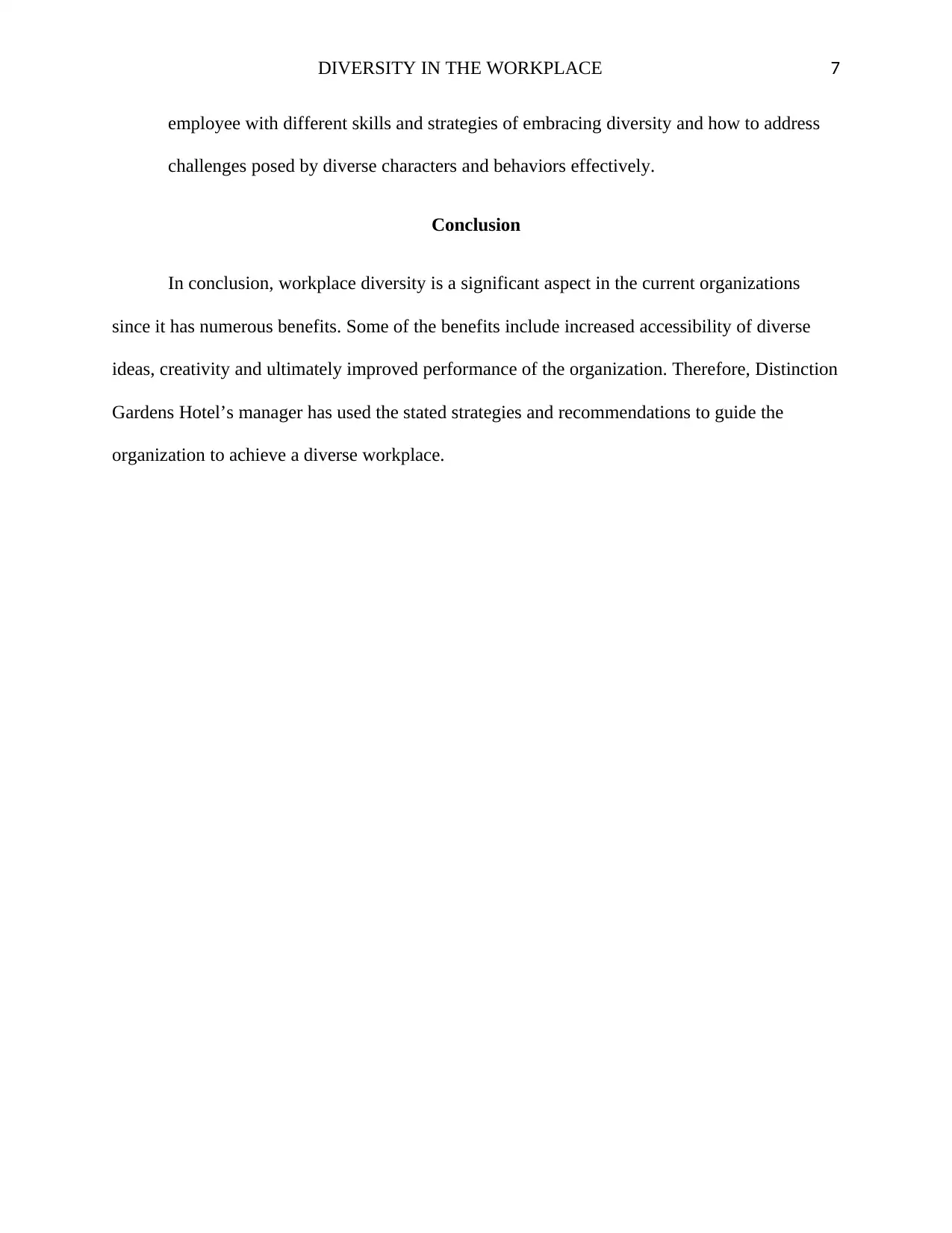
DIVERSITY IN THE WORKPLACE 7
employee with different skills and strategies of embracing diversity and how to address
challenges posed by diverse characters and behaviors effectively.
Conclusion
In conclusion, workplace diversity is a significant aspect in the current organizations
since it has numerous benefits. Some of the benefits include increased accessibility of diverse
ideas, creativity and ultimately improved performance of the organization. Therefore, Distinction
Gardens Hotel’s manager has used the stated strategies and recommendations to guide the
organization to achieve a diverse workplace.
employee with different skills and strategies of embracing diversity and how to address
challenges posed by diverse characters and behaviors effectively.
Conclusion
In conclusion, workplace diversity is a significant aspect in the current organizations
since it has numerous benefits. Some of the benefits include increased accessibility of diverse
ideas, creativity and ultimately improved performance of the organization. Therefore, Distinction
Gardens Hotel’s manager has used the stated strategies and recommendations to guide the
organization to achieve a diverse workplace.
Paraphrase This Document
Need a fresh take? Get an instant paraphrase of this document with our AI Paraphraser
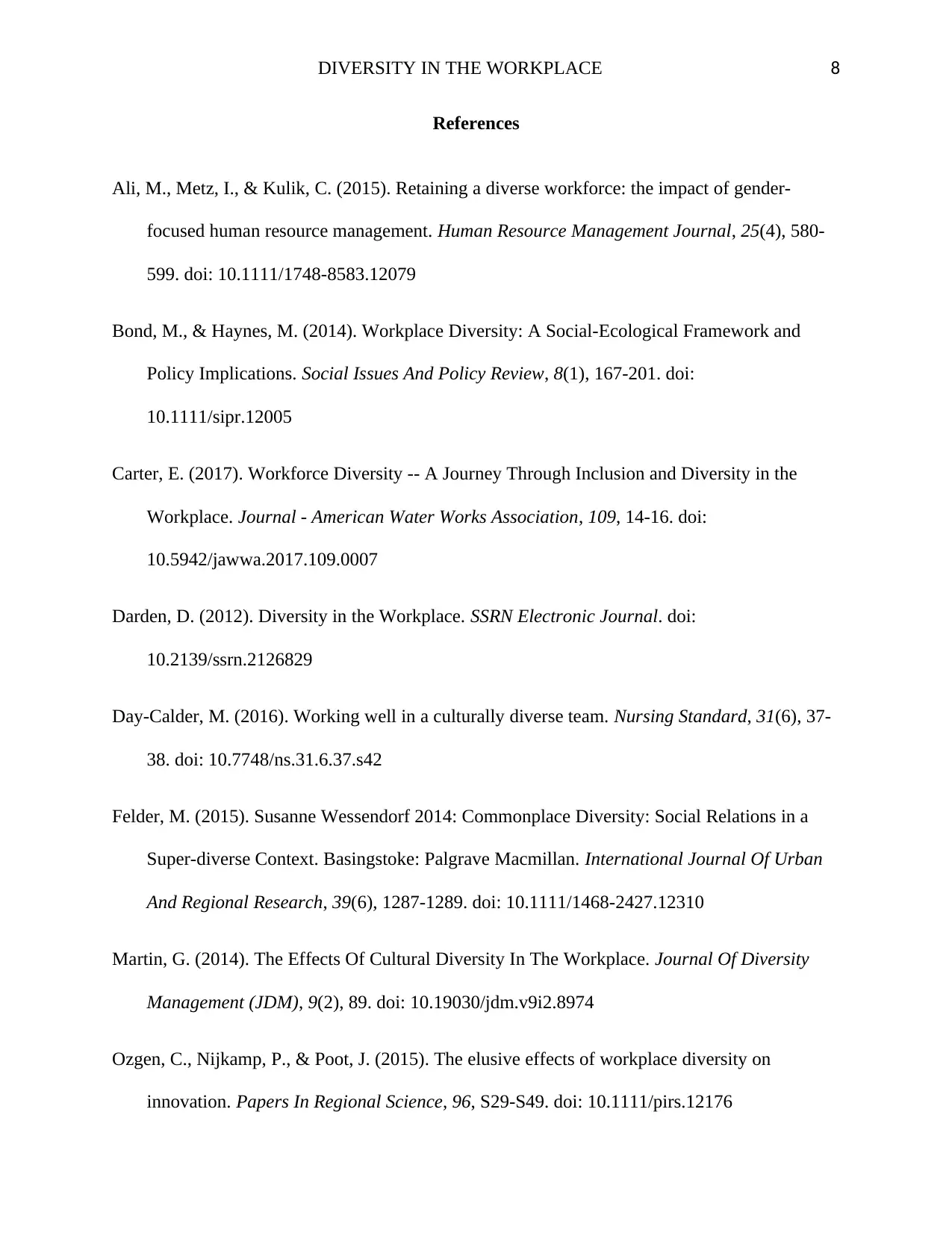
DIVERSITY IN THE WORKPLACE 8
References
Ali, M., Metz, I., & Kulik, C. (2015). Retaining a diverse workforce: the impact of gender-
focused human resource management. Human Resource Management Journal, 25(4), 580-
599. doi: 10.1111/1748-8583.12079
Bond, M., & Haynes, M. (2014). Workplace Diversity: A Social-Ecological Framework and
Policy Implications. Social Issues And Policy Review, 8(1), 167-201. doi:
10.1111/sipr.12005
Carter, E. (2017). Workforce Diversity -- A Journey Through Inclusion and Diversity in the
Workplace. Journal - American Water Works Association, 109, 14-16. doi:
10.5942/jawwa.2017.109.0007
Darden, D. (2012). Diversity in the Workplace. SSRN Electronic Journal. doi:
10.2139/ssrn.2126829
Day-Calder, M. (2016). Working well in a culturally diverse team. Nursing Standard, 31(6), 37-
38. doi: 10.7748/ns.31.6.37.s42
Felder, M. (2015). Susanne Wessendorf 2014: Commonplace Diversity: Social Relations in a
Super-diverse Context. Basingstoke: Palgrave Macmillan. International Journal Of Urban
And Regional Research, 39(6), 1287-1289. doi: 10.1111/1468-2427.12310
Martin, G. (2014). The Effects Of Cultural Diversity In The Workplace. Journal Of Diversity
Management (JDM), 9(2), 89. doi: 10.19030/jdm.v9i2.8974
Ozgen, C., Nijkamp, P., & Poot, J. (2015). The elusive effects of workplace diversity on
innovation. Papers In Regional Science, 96, S29-S49. doi: 10.1111/pirs.12176
References
Ali, M., Metz, I., & Kulik, C. (2015). Retaining a diverse workforce: the impact of gender-
focused human resource management. Human Resource Management Journal, 25(4), 580-
599. doi: 10.1111/1748-8583.12079
Bond, M., & Haynes, M. (2014). Workplace Diversity: A Social-Ecological Framework and
Policy Implications. Social Issues And Policy Review, 8(1), 167-201. doi:
10.1111/sipr.12005
Carter, E. (2017). Workforce Diversity -- A Journey Through Inclusion and Diversity in the
Workplace. Journal - American Water Works Association, 109, 14-16. doi:
10.5942/jawwa.2017.109.0007
Darden, D. (2012). Diversity in the Workplace. SSRN Electronic Journal. doi:
10.2139/ssrn.2126829
Day-Calder, M. (2016). Working well in a culturally diverse team. Nursing Standard, 31(6), 37-
38. doi: 10.7748/ns.31.6.37.s42
Felder, M. (2015). Susanne Wessendorf 2014: Commonplace Diversity: Social Relations in a
Super-diverse Context. Basingstoke: Palgrave Macmillan. International Journal Of Urban
And Regional Research, 39(6), 1287-1289. doi: 10.1111/1468-2427.12310
Martin, G. (2014). The Effects Of Cultural Diversity In The Workplace. Journal Of Diversity
Management (JDM), 9(2), 89. doi: 10.19030/jdm.v9i2.8974
Ozgen, C., Nijkamp, P., & Poot, J. (2015). The elusive effects of workplace diversity on
innovation. Papers In Regional Science, 96, S29-S49. doi: 10.1111/pirs.12176
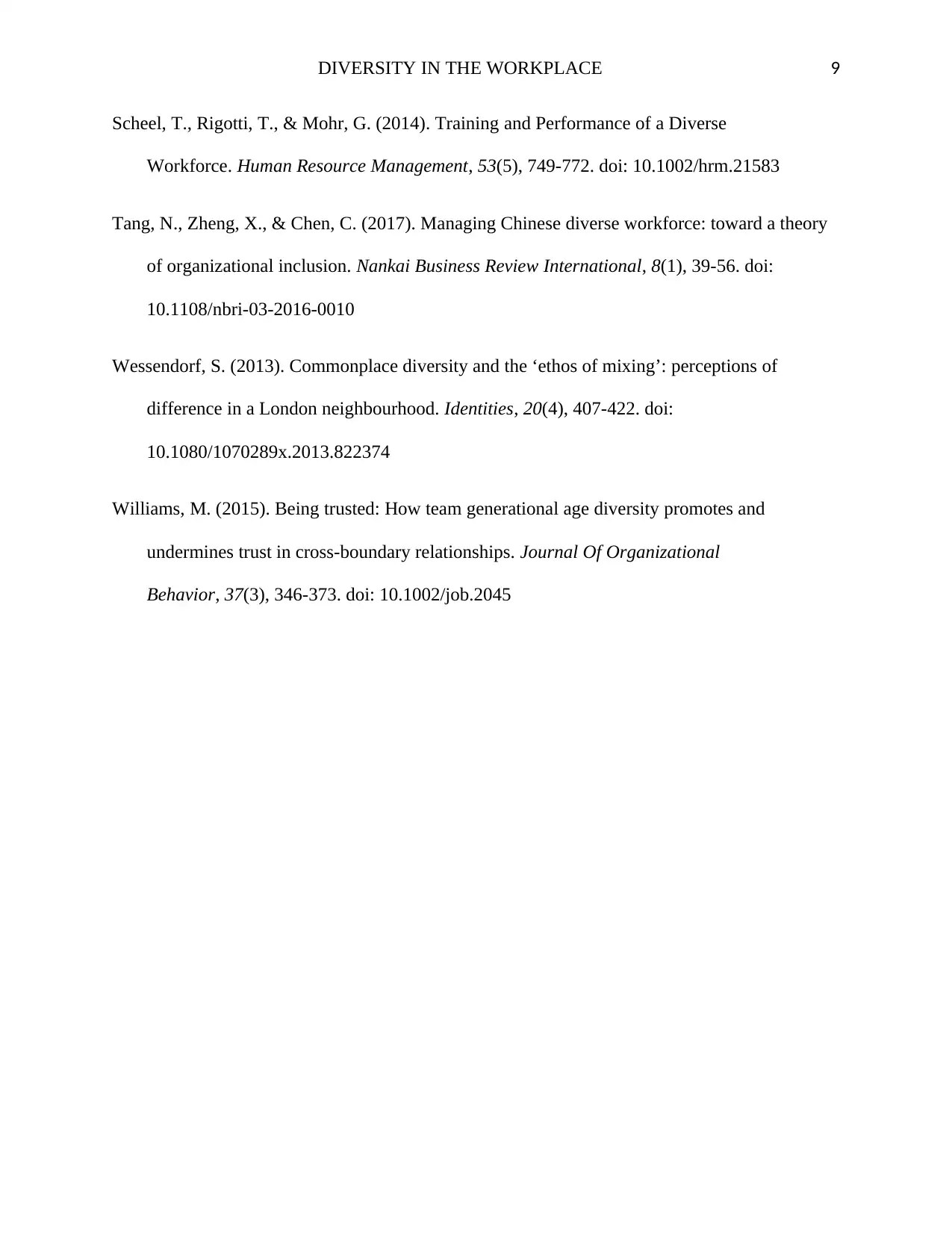
DIVERSITY IN THE WORKPLACE 9
Scheel, T., Rigotti, T., & Mohr, G. (2014). Training and Performance of a Diverse
Workforce. Human Resource Management, 53(5), 749-772. doi: 10.1002/hrm.21583
Tang, N., Zheng, X., & Chen, C. (2017). Managing Chinese diverse workforce: toward a theory
of organizational inclusion. Nankai Business Review International, 8(1), 39-56. doi:
10.1108/nbri-03-2016-0010
Wessendorf, S. (2013). Commonplace diversity and the ‘ethos of mixing’: perceptions of
difference in a London neighbourhood. Identities, 20(4), 407-422. doi:
10.1080/1070289x.2013.822374
Williams, M. (2015). Being trusted: How team generational age diversity promotes and
undermines trust in cross-boundary relationships. Journal Of Organizational
Behavior, 37(3), 346-373. doi: 10.1002/job.2045
Scheel, T., Rigotti, T., & Mohr, G. (2014). Training and Performance of a Diverse
Workforce. Human Resource Management, 53(5), 749-772. doi: 10.1002/hrm.21583
Tang, N., Zheng, X., & Chen, C. (2017). Managing Chinese diverse workforce: toward a theory
of organizational inclusion. Nankai Business Review International, 8(1), 39-56. doi:
10.1108/nbri-03-2016-0010
Wessendorf, S. (2013). Commonplace diversity and the ‘ethos of mixing’: perceptions of
difference in a London neighbourhood. Identities, 20(4), 407-422. doi:
10.1080/1070289x.2013.822374
Williams, M. (2015). Being trusted: How team generational age diversity promotes and
undermines trust in cross-boundary relationships. Journal Of Organizational
Behavior, 37(3), 346-373. doi: 10.1002/job.2045
⊘ This is a preview!⊘
Do you want full access?
Subscribe today to unlock all pages.

Trusted by 1+ million students worldwide
1 out of 9
Related Documents
Your All-in-One AI-Powered Toolkit for Academic Success.
+13062052269
info@desklib.com
Available 24*7 on WhatsApp / Email
![[object Object]](/_next/static/media/star-bottom.7253800d.svg)
Unlock your academic potential
Copyright © 2020–2025 A2Z Services. All Rights Reserved. Developed and managed by ZUCOL.





